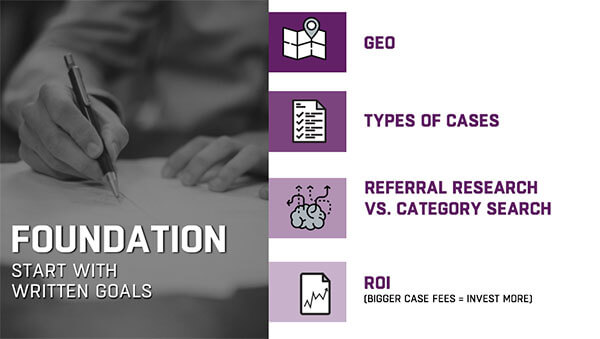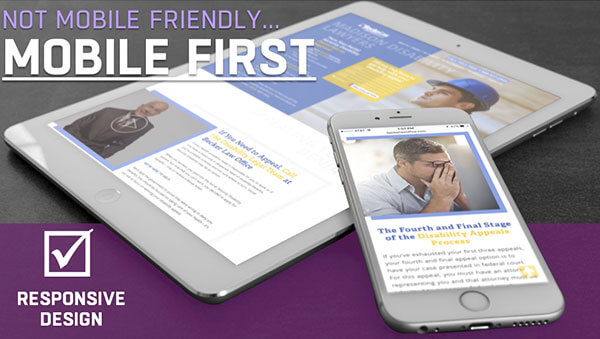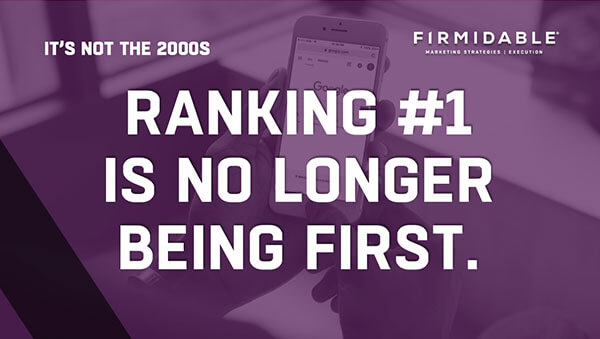For Powerful Law Firm Marketing, Do These 7 Things

For your law firm to prosper and grow, your law firm marketing can’t stand still, especially your digital marketing.
So at Firmidable—a legal marketing agency where we see daily what works for firms across America—we created a checklist of 7 ways that partners and top decision makers can achieve greater returns on their marketing.
We put our insights into an hour-long webcast called “Resolve to Evolve Your Firm Marketing: A 7-Point Checklist,” presented by Nathan Chapman, president of Firmidable.
Or, if you’d rather read a summary of the 7 points, you’ve come to the right blog post.
Here’s what we’ll cover:
- Putting your goals in writing
- Giving clients the best online experience
- Thinking through a client’s journey
- Going mobile first
- Moving beyond websites
- Considering social media
- Going multi-channel
No. 1: Put Your Law Firm Goals in Writing

When law firm partners aren’t getting the results from their digital marketing that they wanted or expected, Nathan said, it’s often because they didn’t start with written goals.
Thinking through and documenting your goals gives you the chance to fill any holes in your ultimate legal marketing strategy.
Nathan listed some of the factors to put into your written plan:
- The geographic areas you want your firm to reach
- The types of legal cases you want to attract—and the priority level of each type of case
- How many clients you get who seek out your firm by name because of referrals vs. how many clients search for your overall category of legal services
- Whether your firm handles a large volume of small cases or a smaller volume of large cases
- Whether the image your law firm projects online has other goals not directly related to cases, such as community involvement, employee recruiting or establishing you as an expert in your field
No. 2: Give Your Potential Legal Clients a Great Experience on the Internet

Silicon Valley types call it the user experience, or “UX.” And when potential clients find you on the internet, you want to make that experience helpful, engaging and ultimately persuasive in guiding them to choose your law firm.
A great user experience includes these elements:
- Writing that focuses on your potential clients, not you
- Websites and other marketing materials translated into other languages, for any non-native English speakers among your clients
- Messages that emphasize your clients’ ultimate goals—the benefits they want out of working with you—not just all the services you provide to get them there
Nathan gave an example using orthopedic surgeons.
He imagined marketing that talks about how compassionate and experienced the doctors are. That’s nice, but is it enough?
What people really want—let’s say after having knee surgery—is an ultimate result like being able to get back on your bike and go for a ride, Nathan said. Talk about those kinds of outcomes in your marketing, not just about the excellent credentials of your lawyers.
“Write stories about your clients, less about the lawyers,” Nathan said.
Now, if your firm is a full-service law firm that has corporations—not individual members of the public—as clients, you might wonder whether this type of messaging still applies.
Nathan offers this reminder: The CEOs, CMOs, in-house counsel and other decision makers for your corporate clients are people, too. Speak to them in a way that addresses their needs.

RELATED
Top Traits of the Most Successful Law Firms
No. 3: Think Through the Journey Law Firm Clients Take on Their Way to You

Full-service law firms and well-established plaintiffs’ law firms might get many or most of their clients through referrals.
But let’s look deeper at the process clients take before hiring your firm. You’ll see how, in addition to your referral network, you need to optimize your digital presence:
Step 1, Referral: A person in need of legal services hears your name from a business associate or personal contact.
What’s the first thing he does? He Googles the firm to check it out.
Step 2, Your Online First Impression: The potential client reaches a search results page. And hopefully, because your firm is on top of its digital marketing, he sees a prominent Google Business Profile (GBP) section about the firm (formerly called Google My Business), complete with photos and contact information.
GBP is a Google feature that acts like a homepage, but one you see before you even reach a firm’s website. The client could contact your firm directly from there.
Step 3, Your Reputation Management: Looking a little closer, the client sees your firm’s star rating in Google Reviews.
Tending to your online reputation by cultivating more and better reviews is an important part of keeping this prospect interested. It’s also important in convincing Google that your firm is a valuable resource to show people searching the web.
“Google’s paying attention,” Nathan said. The search engine giant is “in the business of quality connections.”
“They will score you,” he said, and “they are influenced by the score in those reviews.”
Step 4, Your Pitch to Visit Your Site: If the prospect wants to see more about the firm, he may turn to the link for your website.
Whether he decides to click on that link—and continue considering your firm—could depend on the short description appearing under the link.
That’s called a “meta description.” You can write this yourself, optimizing it to be a strong invitation to visit your site.
Or, if you don’t write one for each page of your site, Google will automatically generate meta descriptions, which can be clipped bits of text that don’t always make much sense.
Step 5, Your Site’s Effectiveness: When the client reaches your site, it needs to be designed to guide him toward the specific action you want him to take, which usually means contacting your firm.
Effective website design means photos that reflect who the client is (ideally custom photography including actual past clients) and a layout that directs his eye toward contacting you.
Step 6, Your Responsiveness to a Lead: Let’s say your online legal marketing has done its job up to this point, and the client reaches out to your firm—becoming a lead.
One study by MIT and Forbes found that you need to respond to an initial contact within five minutes or you risk losing them.
At this stage in the prospect’s journey, you need systems in place to capture them as a client quickly. That can include a Live Chat feature on your site that runs 24 hours a day, or a legal intake call center that answers phone calls at all hours.
No. 4: Make Your Law Firm Website Mobile-First

The need for your website and entire digital strategy to work seamlessly on mobile devices like smartphones isn’t new. We’ve seen clients of our legal marketing agency getting more traffic from mobile devices than desktop computers for a few years now.
But going mobile-first now has greater urgency.
Nathan quoted a Google spokesman saying the search engine doesn’t care about desktop computer searches like it once did.
Google has long declared it will rank new websites optimized for mobile higher than desktop-bound websites.
A key part of being mobile-first is having a site that loads faster, not one encumbered with lots of extra features.
No. 5: Move Your Law Firm Digital Marketing Beyond Your Website

It used to be that the first order of business for law firm digital marketing was to get a good website. Then keep the website producing leads using search engine optimization (SEO).
If your site ranked high in search results for certain keywords, you won. But a great keyword ranking strategy is no longer everything.
That’s because ranking highest in search results no longer guarantees your firm will be seen high on the page.
Readers may first see paid Local Services Ads (LSAs) for lawyers, followed by Paid Search, or pay-per-click ads. Then they may see a Google map with a few top results plotted on it. It’s only after you scroll past that, and possibly past other new Google features, that you arrive at the first website that organically ranks the best because of its SEO.
Website SEO is still a valuable practice, in part because it brings in leads at a lower cost, but the state of today’s internet suggests that you should consider getting into Paid Search advertising even before you focus on improving your website.
Paid Search is faster, easier to scale up, more targeted, more nimble and easier to stop and start than website SEO, which requires a steady commitment.
No. 6: Consider Social Media Advertising for Your Law Firm

Even with privacy issues limiting the data you can use, advertising on social media platforms like Facebook or LinkedIn is a powerful way to reach the right audiences.
The key is that you can’t treat Facebook ads like search ads.
Somebody sees your Google Ads because they searched for the service you provide. You caught them at a time when they’re interested in you.
On Facebook, your ads run the risk of rudely interrupting people who are trying to connect with their friends and family.
Nathan described it as the difference between visiting a car dealer because you want to buy a car vs. having that car dealer show up at your house uninvited.
You can cope with this by designing your ads to speak to people in the appropriate way depending on where they are in the process of hiring a lawyer. That’s how you make your ads relevant to them, instead of annoying.
A prospect could be anywhere from gaining basic awareness of your firm’s existence, to consideration of your firm, to contacting your firm. Marketers call that the “funnel.”
To figure out where someone is in the funnel, and therefore what messages to send them (and avoid giving them a car-dealer hard sell when they’re on social media trying to do something else), you can use marketing automation tools that measure how much a prospect has interacted with your online content so far.
No. 7: Make Your Law Firm Marketing Multi-Channel

Of course, not every situation involves someone searching the internet.
This especially applies in legal practice areas like personal injury, where some law firms have built strong name recognition through other channels.
“I don’t think a lot of people sit in the emergency room and say, ‘I wonder if there’s a personal injury lawyer in my town who will take my case on a contingency fee basis,’” Nathan said. “They’re just thinking, ‘Wow, we need to call So-and-So.’”
Traditional advertising, like television, creates awareness of your firm before a potential client even needs to seek you out online. And TV advertising is still a powerful tool.
When you align the look and message of your TV and digital marketing—and billboards and other channels—that’s even more powerful. Having a consistent brand across channels is one of your best ways to break through the daily blitz of information that all of us face.
A top way to achieve that consistency is to put your marketing under one roof, instead of dividing different tasks among multiple vendors. At our law firm marketing agency, we’ve seen this work well for firms across the country.
“A [building] contractor knows how to get the plumber and the electrician to work well together,” Nathan said. A good ad agency can do the same for a law firm’s TV, digital, outdoor ads and entire revenue-generating strategy.
If you want to evolve your legal marketing, the experts at Firmidable are happy to have a conversation. Let’s get in touch.
Firmidable has been a national expert in legal marketing for over 30 years. It brings law firms customized, data-driven marketing strategies and services, including online and traditional media for a wide range of legal practices. From Maine to Hawaii, it has transformed the lives of attorneys—and their clients.
